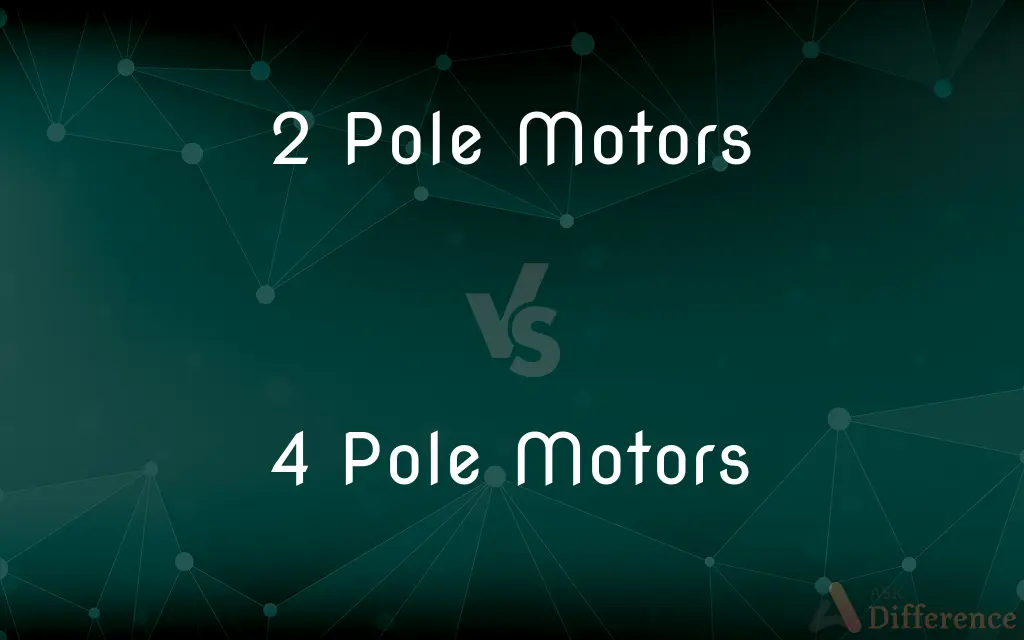2 Pole Motors vs. 4 Pole Motors — What's the Difference?
By Tayyaba Rehman — Published on January 8, 2024
2 Pole Motors operate at higher speeds with one magnetic cycle per revolution, while 4 Pole Motors operate at half the speed with two magnetic cycles per revolution.

Difference Between 2 Pole Motors and 4 Pole Motors
Table of Contents
ADVERTISEMENT
Key Differences
2 Pole Motors, as the name suggests, contain two magnetic poles: one north and one south. This means that for every electrical cycle, there's one complete magnetic cycle. Conversely, 4 Pole Motors contain four magnetic poles: two north and two south. With these additional poles, for every electrical cycle, there are two complete magnetic cycles in the motor.
The operational speed of these motors varies distinctly. 2 Pole Motors, due to having only one magnetic cycle per revolution, tend to operate at higher speeds. In contrast, 4 Pole Motors, with two magnetic cycles per revolution, usually operate at half the speed of their 2 Pole counterparts when supplied with the same frequency of power.
In terms of torque, 4 Pole Motors typically produce more torque at lower speeds compared to 2 Pole Motors. The added poles in 4 Pole Motors provide a greater surface area for creating magnetic fields, resulting in increased torque. On the other hand, while 2 Pole Motors might offer less torque, they excel in applications where higher speeds are crucial.
Application-wise, 2 Pole Motors are commonly found in tools and devices that require higher operational speeds, such as certain fans or centrifuges. 4 Pole Motors, with their characteristic lower speed and higher torque, are more suited for applications like conveyors or pumps, where torque is more important than speed.
Finally, the choice between 2 Pole Motors and 4 Pole Motors largely depends on the specific needs of an application. While both have their advantages, it's essential to select the one that aligns best with the required operational characteristics of a given task.
ADVERTISEMENT
Comparison Chart
Number of Magnetic Poles
2 (1 north, 1 south)
4 (2 north, 2 south)
Speed
Typically higher
Typically lower
Magnetic Cycles
One per electrical cycle
Two per electrical cycle
Torque
Generally less, suitable for high-speed applications
Generally more, suitable for high-torque applications
Common Applications
Fans, centrifuges
Conveyors, pumps
Compare with Definitions
2 Pole Motors
Devices that complete one magnetic cycle for every electrical cycle.
2 Pole Motors are favored in tools that demand rapid motion.
4 Pole Motors
Devices that complete two magnetic cycles for every electrical cycle.
The pump's 4 Pole Motor ensures consistent and strong flow.
2 Pole Motors
Less torque-producing compared to motors with more poles.
For our high-speed drill, a 2 Pole Motor was the perfect fit.
4 Pole Motors
Motors with four magnetic poles, two north and two south.
The conveyor system utilizes a 4 Pole Motor for steady movement.
2 Pole Motors
Typically operate at higher speeds due to fewer poles.
We chose the 2 Pole Motor for the centrifuge because of its fast rotation.
4 Pole Motors
Produce more torque, especially at lower speeds.
The elevator's 4 Pole Motor provides the necessary lifting force efficiently.
2 Pole Motors
Motors with two magnetic poles, one north and one south.
The fan utilizes a 2 Pole Motor for its high-speed operation.
4 Pole Motors
Known for operating at reduced speeds due to increased poles.
For our low-speed mixer, the 4 Pole Motor was ideal.
2 Pole Motors
Preferred for applications where speed outweighs torque.
The blower, needing high RPM, was equipped with a 2 Pole Motor.
4 Pole Motors
Commonly used in applications where torque is prioritized over speed.
The 4 Pole Motor in the crane facilitates heavy lifting with ease.
Common Curiosities
How many magnetic poles do 4 Pole Motors have?
two north and two south.
Why do 2 Pole Motors operate at higher speeds?
2 Pole Motors have only one magnetic cycle per electrical cycle, leading to higher speeds.
Is the torque output the same for 2 Pole Motors and 4 Pole Motors?
No, 4 Pole Motors generally have a higher torque output compared to 2 Pole Motors.
Do 4 Pole Motors produce more torque than 2 Pole Motors?
Yes, 4 Pole Motors typically produce more torque, especially at lower speeds.
In what applications might you find 4 Pole Motors?
4 Pole Motors are commonly used in conveyors, pumps, and applications requiring more torque.
What determines the speed of these motors?
The number of poles and supplied power frequency determine motor speed.
Can I replace a 2 Pole Motor with a 4 Pole Motor in a device?
It depends on the application. Factors like speed and torque requirements should be considered.
Are 4 Pole Motors more energy-efficient than 2 Pole Motors?
Not necessarily. Efficiency depends on the motor design, not just the number of poles.
Are there motors with more than four poles?
Yes, there are 6-pole, 8-pole, and even higher pole count motors for specific applications.
What are 2 Pole Motors known for?
2 Pole Motors are known for their higher operational speeds.
How do the magnetic cycles differ between 2 Pole and 4 Pole Motors?
2 Pole Motors complete one magnetic cycle per electrical cycle, while 4 Pole Motors complete two.
Why would someone choose a 4 Pole Motor over a 2 Pole Motor?
They might need more torque, or a slower operational speed might be beneficial.
Is one motor type better than the other?
Neither is universally better; the choice depends on the application's requirements.
Do 2 Pole Motors have less magnetic interaction?
Yes, with only one magnetic cycle per revolution, their magnetic interaction is reduced.
How does the number of poles affect the motor's frequency needs?
The number of poles inversely affects the motor's speed for a given frequency.
Share Your Discovery

Previous Comparison
Phase Diagram vs. Equilibrium Diagram
Next Comparison
Pros vs. ConsAuthor Spotlight
Written by
Tayyaba RehmanTayyaba Rehman is a distinguished writer, currently serving as a primary contributor to askdifference.com. As a researcher in semantics and etymology, Tayyaba's passion for the complexity of languages and their distinctions has found a perfect home on the platform. Tayyaba delves into the intricacies of language, distinguishing between commonly confused words and phrases, thereby providing clarity for readers worldwide.













































